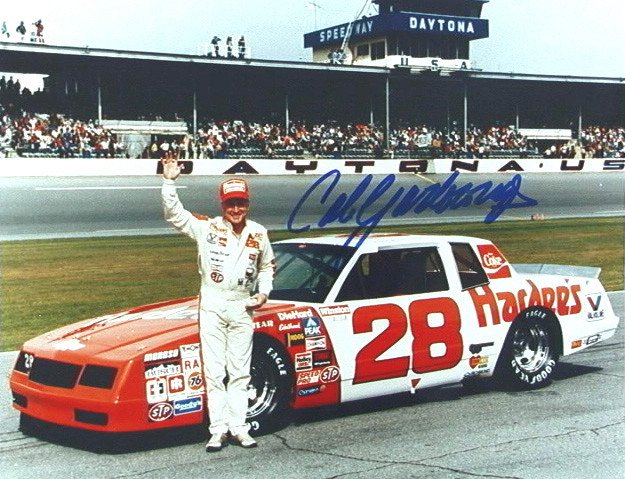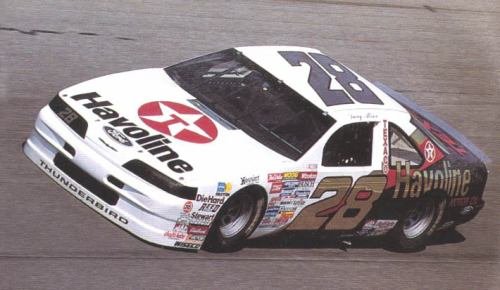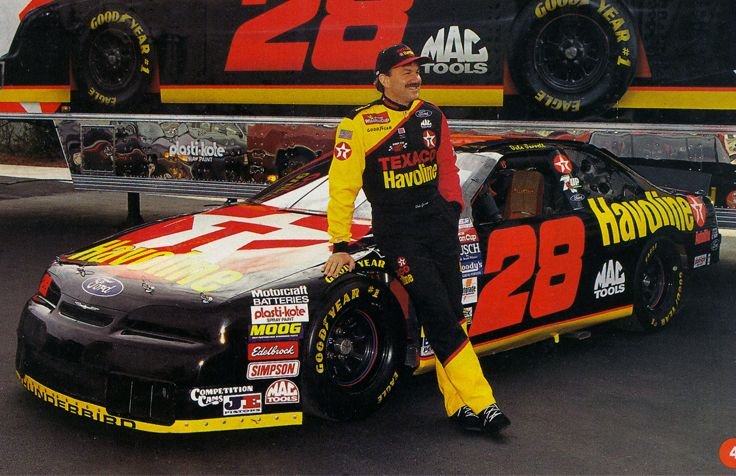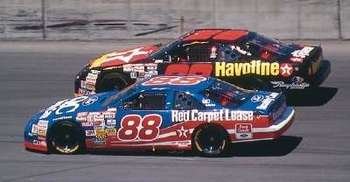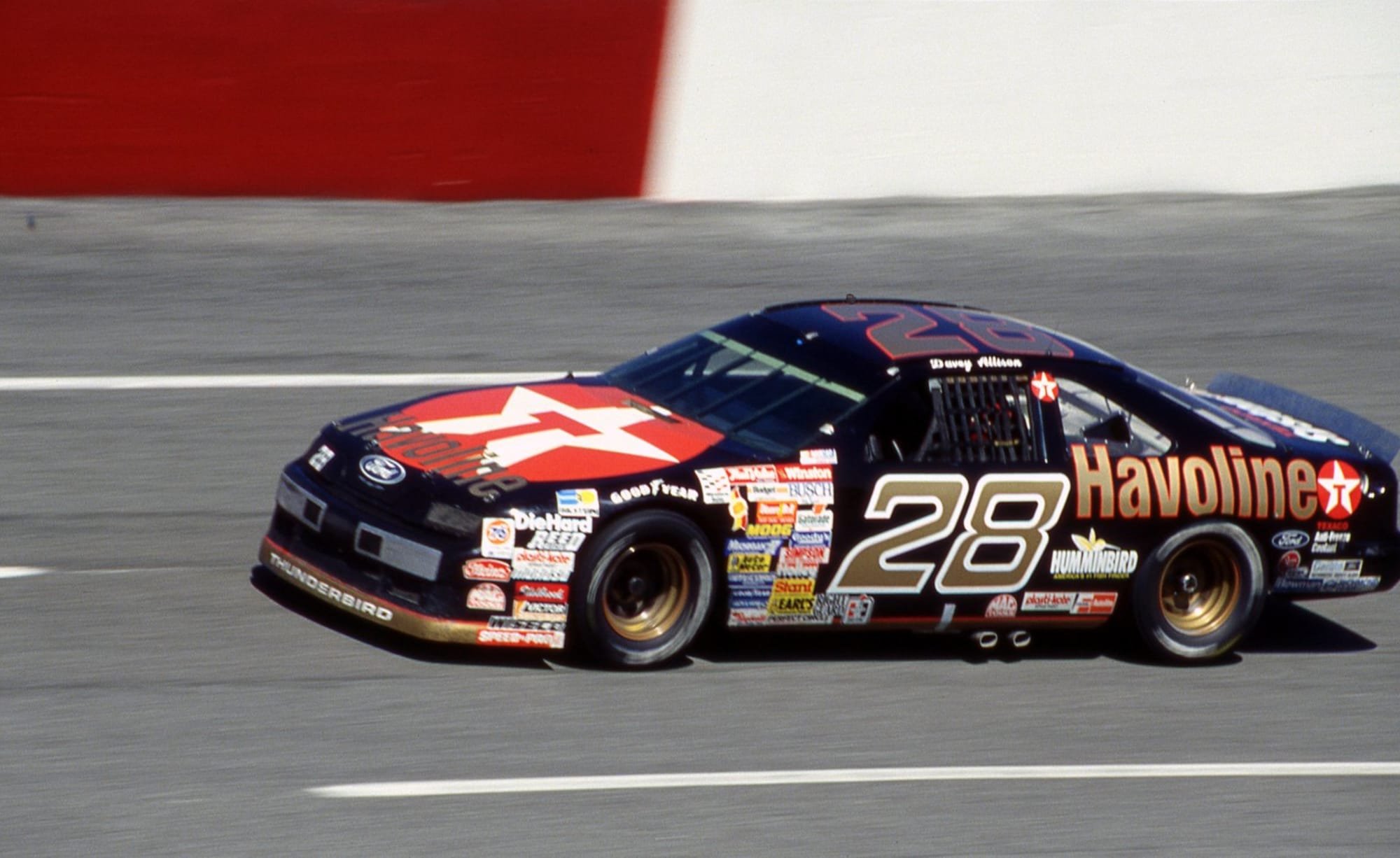
In NASCAR Cup Series competition the #28 car has started 1032 races with 61 drivers and has 76 wins, 94 pole, 299 top 5s, 437 top 10s, and 284 DNFs.
The number 28 car was fielded consistently by the same team from 1979-2002. The first of these drivers was Buddy Baker who drove for the Rainer-Lundy team from 1979-1980 and again in 1982 with Waddell Wilson as the crew chief. In his 60 career starts in #28 Baker earned 5 wins including the 1980 Daytona 500, the fastest ever run (177 mph).
In 1981 Bobby Allison drove the #28 to 5 wins in 31 starts including the World 600.
Cale Yarborough took over the Rainer-Lundy #28 in 1983 with Hardee’s as the sponsor. Yarborough won 9 races in the car including the last win of his career in 1985. In 1986 Yarborough took the Hardee’s sponsorship to found his own team with #29.
Davey Allison is the son of Bobby, a former driver of the 28, and proved his worth immediately by qualifying on the pole of the Daytona 500, as a rookie. This feat had never been accomplished before. In 1988 the Rainer-Lundy team was sold to the long time engine builder and crew chief in the shop, and the company was renamed Robert Yates Racing. The young superstar Allison would win 19 events in just 6 seasons, and finished a best of 3rd in the standings twice. He pushed his father to the win in the 1988 Daytona 500, earned his own 1992 Daytona 500 win , and headed into 1993 as a championship threat.
On Monday, July 12, 1993, Davey Allison boarded his newly acquired Hughes 369HS helicopter to fly to Talladega Superspeedway to watch family friend Neil Bonnett and his son David test a car for David’s Busch Series debut. He picked up another family friend, legendary racer Red Farmer, en route to the track. Allison was attempting to land the helicopter inside a fenced-in area of the track infield when the craft nosed up suddenly, then crashed. The National Transportation Safety Board blamed the crash on Allison’s inexperience in helicopters, coupled with the decision to attempt a landing. Neil Bonnett was able to free a semi-conscious Farmer from the wreckage, but Allison was unresponsive and could not be freed until paramedics arrived. Farmer would go on to a lengthy but successful recovery, but Allison never regained consciousness after sustaining a critical head injury. He was pronounced dead at 7:00 a.m. the next morning. Davey started 183 races in the number 28, the most of any driver.
The week following Allison’s death Robby Gordon drove the #28 at Allison’s home track of Talladega, the site of his accident. It was Robby’s 3rd start in a Winston Cup Car and only start in #28. Lake Speed drove the next 3 races in #28.
When his friend Davey Allison died, former Daytona 500 winner Ernie Irvan wanted to take his place in #28. Mogran-McClure Motorsports did not want to let him leave the #4 car he was currently driving, so Irvan filed a lawsuit. After a month of negotiations Irvan was fired from MMM and finished the 1993 season in the #28 with 2 wins.
In 1994 Irvan was a favorite for the Winston Cup Championship, and after 20 races he had 3 wins and was trailing only Dale Earnhardt for the lead in the point standings. Irvan’s season came to an end after a hard crash during a practice session at Michigan. According to drivers on the track, a right front tire deflated, sending Irvan’s car into the turn two wall at over 170 miles per hour. Emergency workers at the track extricated him from the car, and he was immediately airlifted to Saint Joseph’s Hospital in Ann Arbor, Michigan. He was diagnosed with critical brain and lung injuries and given only a 10% chance of surviving the night. Irvan clung to life for the first two days. By early September, Irvan was listed in “fair” condition and was removed from ventilator support. A few weeks later he was deemed well enough to be transferred to the Charlotte Institute of Rehabilitation in Charlotte. A few weeks following the transfer, Ernie appeared and addressed the fans at the Charlotte Motor Speedway at the start of the UAW-GM 500. Less than two months later, at the gala NASCAR Awards Banquet in New York, Irvan walked on stage at the Waldorf-Astoria Hotel’s Grand Ballroom to receive the True Value Hard Charger Award. Despite missing the final 11 races at the end of the season, Irvan had still ranked among the top five for the most laps led. In addition, Irvan tied Geoff Bodine for the most poles won during the season. Kenny Wallace would drive the #28 for the rest of 1994.
In 1995 Irvan continued to recover from his accident, so Robert Yates hired Dale Jarrett to take over the #28 car. Jarrett earned 1 win that year at Pocono . On October 1 at North Wilkesboro, Irvan returned to Cup Series racing. Since Dale Jarrett had taken the seat of his No.28 car, Irvan instead ran a car numbered 88 but also sponsored by Texaco Havoline.
Irvan would return full time for the 1996 season, retaking his #28 . Dale Jarrett performed well as a substitute, so Yates Racing expanded to a two car team with Jarrett in #88. Irvan would win 3 more times between 1996 & 1997. To the shock of many, Irvan was fired from RYR at the end of 1997 and went to drive the #36 for MB2 Motorsports. Irvan started 92 races in car #28 with 8 wins. Jarrett started 31 races in the #28 car with 1 win. Kenny Wallace started 10 races in the #28.
Starting in 1998 Kenny Irwin Jr. took over the wheel of the #28. Despite winning Rookie of the Year honors in 1998, Irwin failed to find victory lane in his two seasons. He is also known for one incident where he bumped the car of Tony Stewart , a former rival of his in USAC open-wheel competition, into the wall in the Goody’s 500 at Martinsville Speedway. After 66 starts in #28, Irwin left RYR to drive the #42 for Felix Sabates for the 2000 season. He would be killed in a crash at New Hampshire International Speedway after his throttle stuck during a practice session.
Following the departure of Irwin, Ricky “The Rooster” Rudd took over the #28 car. He would go on to drive 3 seasons in the Havoline Ford, from 2000-2002, and won his first race for the team in 2001 at Pocono after going winless since 1998. Rudd drove the #28 to Victory Lane two additional times, Richmond in 2001 and his final victory at Infineon in 2002 , and finished in the top ten in the standings all 3 seasons, including 4th in 2001, his 2nd highest career points finish. Rudd left the team to join Wood Brothers Racing in 2003, while Yates hired the Wood’s previous driver, Elliott Sadler and Robert Yates switched from #28 to #38 along with sponsorship from Mars, Inc.
Yates Racing brought back the #28 car in 2008 with Travis Kvapil behind the wheel. Despite being very underfunded the team managed to put together a respectable season with Kvapil earning 4 top 10s and finishing 23rd in points. After only 4 races in 2009 the #28 team shut down due to lack of sponsorship. Yates Racing continued to field the #98 with Paul Menard for the rest of 2009, but in 2010 Yates disbanded the team. The Yates name is still alive in the world of engine building, providing horsepower for Ford teams.
Fred Lorenzen drove #28 for 125 of his 158 career starts, and scored 25 of his 26 career wins in the number. Lorenzon won the 1963 & 1965 Grand National (Cup Series) most popular driver award and is considered one of the first superstars of the sport. At Darlington in 2008 the unsponsored #28 car of Travis Kvapil paid tribute to Lorenzon by running a car painted to resemble his old Ford.
Eddie Skinner drove the #28 68 times from 1963-1968.
From 1968-1971 Earl Brooks started #28 in 24 races. As one of the earliest professionals of any sport, he played the game simply to feed his family and to be a breadwinner to his family. Brooks never had the money or the time attract corporate sponsors for his racing team. His “second job” was being a mechanic for a garage on Lynchburg’s Mayflower Drive; where he worked from Monday to Friday to pay off any bills that NASCAR couldn’t help with. In the summertime, Earl would wear sandals while racing; something that would eventually become banned as NASCAR became more safety conscious. Like any other driver who raced during the formative years of NASCAR, Brooks was a humble man who would sometime race for meager “awards” like a block of cheese or a tin of crackers to eat for a snack after the race. While Richard Petty and David Pearson could buy new parts for their vehicles through their corporate sponsors spending money like there was no tomorrow, Earl had to scrounge around for vehicle components. Due to Brooks being unable to win a race in the NASCAR Cup Series, he is ineligible for the NASCAR Hall of Fame as a driver.
Buddy Helms raced this car in the first sanctioned race in 1949, and was (obviously) the first to race the 28. Helms made a total of 4 starts in #28.
On May 24, 2017, Robert Yates, longtime owner of car #28, was voted into the NASCAR Hall of Fame’s Class of 2018. Unfortunately, Yates died of liver cancer October 2, 2017, before being inducted. Former driver Dale Jarrett read Yates’ acceptance speech in his place.
Other notable names in #28
Benny Parsons , 14 starts
A.J. Foyt , 14 starts
Charlie Glotzbach , 8 starts
Bobby Isaac , 7 starts
Lake Speed, 3 starts
Chad Little, 3 starts
Junior Johnson, 1 start
Dan Gurney , 1 start


